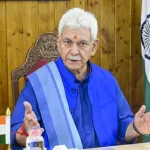In the sacred heart of Kashmir’s mythic geography, where the mountains hum hymns of ancient gods and the rivers carry the scent of time itself, lies Tulmulla—the quiet cradle of Ksheer Bhawani. The goddess who once reigned serenely from this chinar-shaded shrine has since become a silent traveler, a deity in diaspora, a soul wrapped in the soft grief of her people’s exile.
The shrine of Ksheer Bhawani in Tulmulla is no ordinary sacred space. Crafted in gleaming white marble and nestled beside a spring whose waters shimmer like milk, it once pulsed with the rhythms of devotion, tradition, and timeless communion. The sacred spring, its clarity often said to change color, was regarded as a divine oracle—a celestial mirror reflecting the moods of the goddess and foretelling the destinies of her people. To witness the waters shimmer blue was to feel the grace of divinity; to see them darken was to sense ominous undercurrents, the foreshadowing of sorrow.
Each year, during Jyeshtha Ashtami, a golden tide of faith would rise and flow into Tulmulla. Kashmiri Pandits—men, women, children, elders—would travel from across the Valley to gather in joyful celebration, singing bhajans under the shade of ancient chinars, lighting lamps, sharing prasad, and offering ksheer, the sweetened milk from which the goddess takes her name. It was not merely a festival; it was a pilgrimage woven into the DNA of a community, a luminous circle that bound worshippers to the divine and to each other.
But that sacred circle was ruptured in the early 1990s, when the Valley’s silence was pierced by the shrill cries of hatred and fear. The mass exodus of Kashmiri Pandits was not merely a demographic shift—it was a cultural unraveling, a tearing of roots from soil soaked with centuries of devotion. The songs fell silent. The springs stilled. Footsteps vanished from sacred thresholds. And yet, in the tremulous hours of departure, amidst the confusion of suitcases and farewells, they carried something more vital than belongings—they carried the goddess herself.
Mata Ksheer Bhawani, once rooted deeply in the hallowed earth of Tulmulla, became a nomadic presence. She journeyed with her devotees, folded into the fabric of memory, draped in the shawl of nostalgia, and enshrined within the flickering light of household diyas in alien lands. From refugee camps in Jammu to one-room flats in Delhi, from the burning plains of Nagrota to the humid lanes of Pune, she arrived not in chariots, but in the quiet strength of prayer, in the resilience of her people.
She transformed—not diminished. In a profound deviation from most Hindu deities who remain tethered to the temples of their origin, Ksheer Bhawani became migratory, diasporic. She was no longer solely the goddess of Tulmulla. She became the goddess who walked with her people. She wept in tents. She listened in concrete silence. She smiled from modest shrines built beside gas stoves and between suitcases and calendars that bore memories of home.
In this unexpected transformation lies an echo of deep mythic significance. Deities, in Hindu tradition, often emerge from mountains, rivers, forests—but they seldom leave them. They bless the land they inhabit, drawing pilgrims to their sacred soil. But Ksheer Bhawani inverted this idea. She walked in reverse—following, not summoning. She chose her people over permanence, memory over marble.
And in that exile, something miraculous happened. She grew closer. In her absence from Tulmulla, she became omnipresent. She now lived in stories, in lullabies, in whispered mantras, in the wrinkled hands of grandmothers who narrated tales of the sacred spring to children who had never seen it. Her shrine now lives in the ache of longing and the balm of remembrance. She no longer demands gold or incense—she accepts garlands of nostalgia and offerings of poetry, the tears of exile, and the courage of survival.
And still, every year, Jyeshtha Ashtami dawns with renewed devotion. Thousands of devotees, with trembling hearts and tear-brimmed eyes, make the sacred journey to Tulmulla—risking distance, fatigue, and memory’s weight. They walk beneath the chinars, bathe in the light of recollection, and offer prayers that stitch the ruptured past with threads of faith.
But many more—perhaps the majority—remain where they are: in Jammu’s migrant colonies, in Delhi’s crowded alleys, in the cool basements of Toronto, in New Jersey’s suburban quietude. They do not walk the stone paths of Tulmulla, but they walk the inward paths of remembrance. They may not touch the spring, but they touch the silence within them where the spring once flowed. They gather in refugee colonies and community halls, where images of the goddess stand between posters of the lost homeland and photos of martyrs. They sing her aarti not in chorus under the open sky, but in small gatherings where voices rise against the din of loss.
And it is here that the goddess breathes—alive in the vibration of devotion unbroken by geography. Whether the diya flickers in a tent in Jagti or on a polished windowsill in London, it is the same flame, the same prayer. The children who speak her name for the first time do not learn just a syllable—they inherit centuries of belonging. The mothers who fold their hands before her murti in modest mandirs are not just praying—they are anchoring a world that risks drifting.
Across Pune, Bhopal, Noida, Faridabad, and beyond Indian shores—in New York’s quiet temples and Sydney’s cultural sabhas—Ksheer Bhawani is remembered, invoked, and lovingly adorned. Her devotees, though scattered by fate, celebrate her day with equal intensity. In these spaces, the festival is not diminished by absence—it is deepened by the yearning it invokes.
The goddess, now untethered from one spring, drinks from the tributaries of dispersed devotion. She hears the songs sung in languages touched by distance, she sees the eyes glisten with the ache of return, and she blesses those who remember.
In this way, Ksheer Bhawani becomes not merely a religious figure, but a mirror to the collective soul of the Kashmiri Pandit community. Her journey is theirs. Her silence echoes their silence. Her tears mix with theirs. Her resilience reflects theirs. She is not static. She is dynamic, transforming, evolving, enduring—just like the people who carry her in their hearts and on their altars.
Her image stands beside photographs of snow-covered houses left behind, beside copper utensils no longer used but lovingly preserved, beside shawls that still smell of grandmothers. In such fragments, the goddess resides. She is the glue of memory, the spirit of continuity.
One day—perhaps soon, perhaps in a future written by the courage of return—the footsteps may echo once more through the chinar groves of Tulmulla. Children born in exile may touch the water of the sacred spring for the first time. Old men may weep in silence as they see the goddess where she first stood. Songs will rise again under the open sky. Diyas will float across the milky waters. And Ksheer Bhawani will no longer be the wandering goddess—she will be the welcoming mother.
But until that day arrives, she continues her journey. She is the goddess of the road, the altar, the memory, the kitchen, the story, the sigh. She is there in the rustle of old letters, in the yellowed pages of dusty books, in the tears of prayer, in the smiles of stubborn survival. She walks in homes that never stop whispering “Tulmulla.” She lives in the homes of those who never returned, but never forgot.
Ksheer Bhawani has become a deity of the heart’s landscape. Her shrine today is not limited to marble walls—it lies in the poetry of longing, the rituals of remembrance, the festivals celebrated with trembling hands and unwavering faith, wherever her devotees reside. And as the diaspora grows, so does she.
She is the goddess who remembers. And because she remembers, her people do not forget.
(Author is RK Columnist and can be reached at: [email protected])








